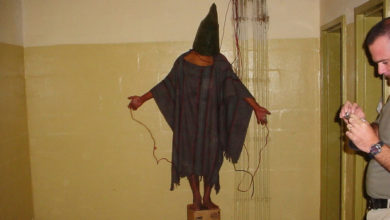Police Patrol Hong Kong Park to Enforce Tiananmen Vigil Ban

HONG KONG — Heavy police force patrolled Hong Kong’s Victoria Park on Saturday after authorities for a third consecutive year banned public commemoration of the anniversary of the deadly Tiananmen Square crackdownin 1989, with vigils overseas the only place marking the event.
For decades, Hong Kong and nearby Macao were the only places in China allowed to commemorate the violent suppression by army troops of student protesters demanding greater democracy in Beijing’s Tiananmen Square on June 4, 1989. Many were among the many victims.
It is believed that the ban is part of Beijing’s move to suppress political dissent.
After many of the leaders of the Hong Kong Alliance in Support of Patriotic Democratic Movements of China were detained on suspicion of violating a national security law that was passed in response to massive protests in 2019, the vigil organizers had to disband.
Public commemoration has been banned by authorities in the three-year period due to risks from coronavirus. Critics argue that the pandemic serves as an excuse for infringing on the rights to gather.
A government statement Friday said that parts of Victoria Park, which traditionally served as the venue for the candlelight vigil, will be closed as it may be used for “illegal activities.” The move was to “prevent any unauthorized assemblies” in the park and to reduce the possibility of COVID-19 spread.
Earlier in the week, a police superintendent warned that anyone who gathered in a group “at the same place, with the same time and with a common purpose to express certain views” could be considered part of an unauthorized assembly.
Residents wore black, in silent support of the ban. Some even carried bouquets, candles and turned on flashlights on their smartphones.
“Today, this is to commemorate June 4th. Every year I have to do it,” said Man Yuen, who appeared in a black T-shirt with the words “the people will not forget” while walking down the streets carrying an unlit candle.
Police searched several individuals, including some who were wearing black clothing. There are no details on whether any arrests have been made.
“I am disappointed because although no one organized any commemoration event, the authorities are already on high alert,” said Donald Tam, who was shopping in the Causeway Bay district, where the park is located.
Since the British handed over Hong Kong to China in 1997, the city has been governed under a “one country, two systems” framework that promised it liberties not found on the mainland, including freedom of speech and assembly. The 1989 crackdown was commemorated in Hong Kong and Macao (a nearby semi-autonomous territory). Elsewhere in China, keywords such as “Tiananmen massacre” and “June 4” are strictly censored online, and people are not allowed to publicly mark the event.
Outside China, Vigils were held in memory of the Tiananmen victim.
Antony Blinken, U.S. Secretary, stated that even though China and Hong Kong tried to erase the memory of the crackdown in China, the government of his country would still speak out against China’s human rights violations, which included those committed in Hong Kong against Muslim minorities living in western Xinjiang and Tibet.
“To the people of China and to those who continue to stand against injustice and seek freedom, we will not forget June 4,” he said.
Candles were lit by the U.S. Consulate of Hong Kong in the windows.
Many took part in the Taiwan vigil, which was held on a Taiwanese island that Beijing claimed as its territory. The Foreign Ministry wrote on Facebook that “when this time of year comes around, there is a lot one can’t say, a lot one can’t write, and a lot one can’t even look up on the internet.”
The post encouraged Chinese citizens who use a VPN to access Facebook, which is blocked in China, and search for information on the Tiananmen Square massacre “to see what their country is hiding from them.”
“Taiwan has been commemorating the June 4 massacre before Hong Kong did, and each place (in the rest of the world) that holds this event interprets it in its own ways,” said Taiwan democracy activist Lee Ming-che. “We must be aware of China’s threats and protect Taiwan’s values of democracy, human rights, and freedom.”
Joanna Chen is a graduate student who said the importance of commemorating the killings on June 4, 2008 is because Taiwan is among the few countries in Greater China where such events are publicly remembered.
“We must remind the Taiwanese people that democracy should not be taken for granted,” she said.
To commemorate the massacre in Sydney, around 50 people supporting democracy placed candles at the Chinese Consulate. A few police officers remained on the watch.
In the Indian city of Dharmsala, home to Tibet’s exiled spiritual leader the Dalai Lama, activists organized a street theater to mark the Tiananmen anniversary. They used a cutout of a Chinese tank to recreate the “tank man,” an iconic image taken by The Associated Press of a student standing in front of a tank, which came to symbolize courage in the face of Chinese government’s crackdown of the protest.
For the first time in 30 years, Hong Kong’s Catholic churches also skipped Mass for the Tiananmen victims, after the diocese expressed concerns that such events could violate the national security law.
Authorities have been using the law to crack down on the opposition, with over 150 people arrested on suspicion of offences that include subversion, secession, terrorism and foreign collusion to intervene in the city’s affairs.
University campuses were included in the crackdown. In December 2021, a sculpture called “Pillar of Shame,” which depicts torn and twisted bodies symbolizing the lives lost during the massacre, was taken down at the University of Hong Kong. Officials claimed that the statue could not be displayed without approval.
The monuments were removed by two universities within the same city the next day.
In response, Jens Galschioet, the artist who created “Pillar of Shame,” last week unveiled a full-scale replica of the 8-meter- (26 foot) tall sculpture at the University of Oslo in Norway.
___
The report was co-authored by Ashwini Bhatia and Ashwini Fung (Associated Press), in Dharmsala. India.
Read More From Time





